brake sensor VOLVO V60 2014 Owner's Manual
[x] Cancel search | Manufacturer: VOLVO, Model Year: 2014, Model line: V60, Model: VOLVO V60 2014Pages: 442, PDF Size: 13.85 MB
Page 225 of 442
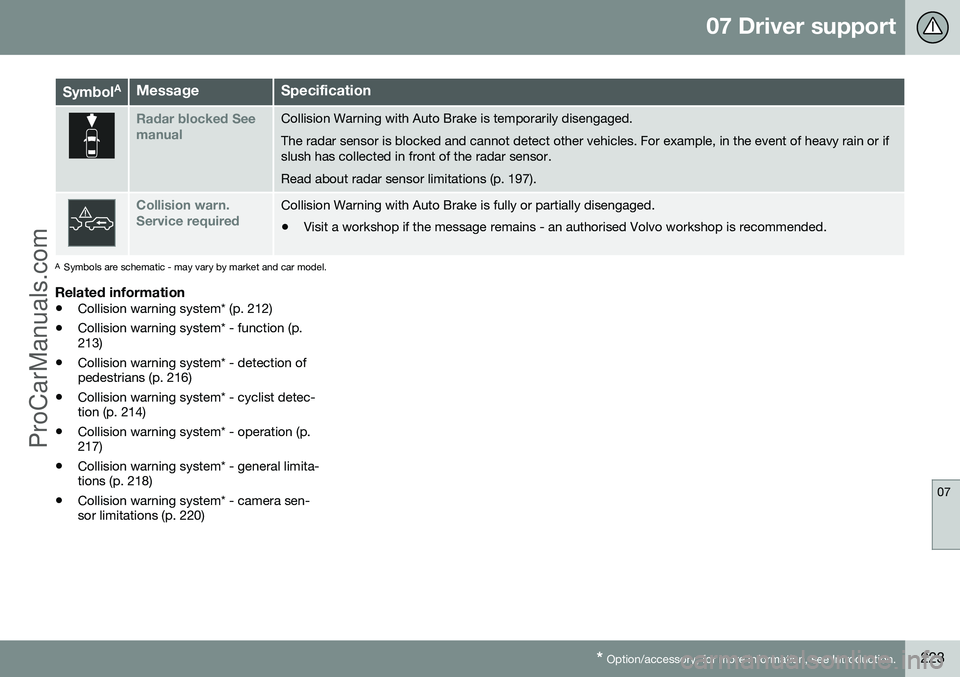
07 Driver support
07
* Option/accessory, for more information, see Introduction.223
Symbol AMessageSpecification
Radar blocked See manualCollision Warning with Auto Brake is temporarily disengaged. The radar sensor is blocked and cannot detect other vehicles. For example, in the event of heavy rain or if slush has collected in front of the radar sensor. Read about radar sensor limitations (p. 197).
Collision warn. Service requiredCollision Warning with Auto Brake is fully or partially disengaged.
• Visit a workshop if the message remains - an authorised Volvo workshop is recommended.
A
Symbols are schematic - may vary by market and car model.
Related information
• Collision warning system* (p. 212)
• Collision warning system* - function (p. 213)
• Collision warning system* - detection ofpedestrians (p. 216)
• Collision warning system* - cyclist detec-tion (p. 214)
• Collision warning system* - operation (p.217)
• Collision warning system* - general limita-tions (p. 218)
• Collision warning system* - camera sen-sor limitations (p. 220)
ProCarManuals.co’
Page 233 of 442
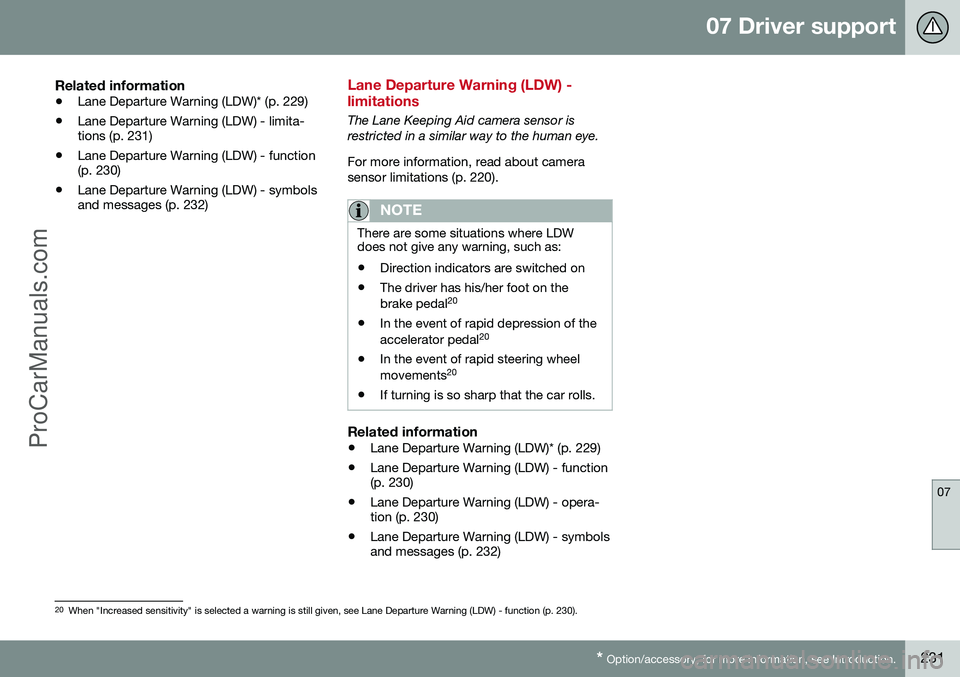
07 Driver support
07
* Option/accessory, for more information, see Introduction.231
Related information
• Lane Departure Warning (LDW)* (p. 229)
• Lane Departure Warning (LDW) - limita- tions (p. 231)
• Lane Departure Warning (LDW) - function(p. 230)
• Lane Departure Warning (LDW) - symbolsand messages (p. 232)
Lane Departure Warning (LDW) - limitations
The Lane Keeping Aid camera sensor is restricted in a similar way to the human eye. For more information, read about camera sensor limitations (p. 220).
NOTE
There are some situations where LDW does not give any warning, such as:
• Direction indicators are switched on
• The driver has his/her foot on the brake pedal 20
• In the event of rapid depression of theaccelerator pedal 20
• In the event of rapid steering wheelmovements 20
• If turning is so sharp that the car rolls.
Related information
•
Lane Departure Warning (LDW)* (p. 229)
• Lane Departure Warning (LDW) - function (p. 230)
• Lane Departure Warning (LDW) - opera-tion (p. 230)
• Lane Departure Warning (LDW) - symbolsand messages (p. 232)
20
When "Increased sensitivity" is selected a warning is still given, see Lane Departure Warning (LDW) - function (p. 230).
ProCarManuals.co’
Page 244 of 442
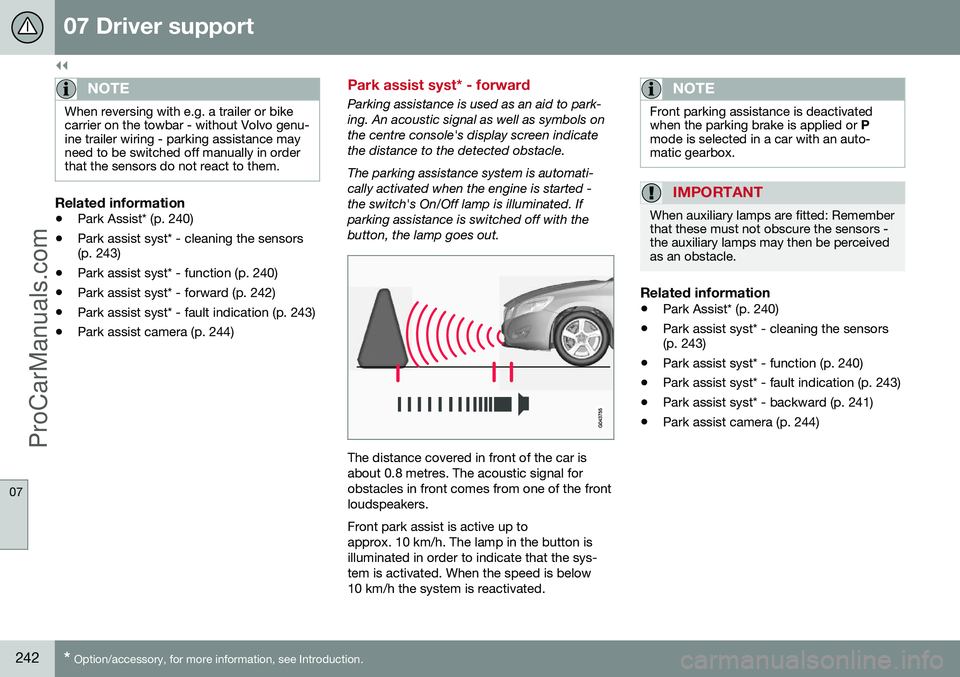
||
07 Driver support
07
242* Option/accessory, for more information, see Introduction.
NOTE
When reversing with e.g. a trailer or bike carrier on the towbar - without Volvo genu-ine trailer wiring - parking assistance mayneed to be switched off manually in orderthat the sensors do not react to them.
Related information
• Park Assist* (p. 240)
• Park assist syst* - cleaning the sensors (p. 243)
• Park assist syst* - function (p. 240)
• Park assist syst* - forward (p. 242)
• Park assist syst* - fault indication (p. 243)
• Park assist camera (p. 244)
Park assist syst* - forward
Parking assistance is used as an aid to park- ing. An acoustic signal as well as symbols onthe centre console's display screen indicatethe distance to the detected obstacle. The parking assistance system is automati- cally activated when the engine is started -the switch's On/Off lamp is illuminated. Ifparking assistance is switched off with thebutton, the lamp goes out.
The distance covered in front of the car is about 0.8 metres. The acoustic signal forobstacles in front comes from one of the frontloudspeakers. Front park assist is active up to approx. 10 km/h. The lamp in the button isilluminated in order to indicate that the sys-tem is activated. When the speed is below10 km/h the system is reactivated.
NOTE
Front parking assistance is deactivated when the parking brake is applied or
P
mode is selected in a car with an auto-matic gearbox.
IMPORTANT
When auxiliary lamps are fitted: Remember that these must not obscure the sensors -the auxiliary lamps may then be perceivedas an obstacle.
Related information
• Park Assist* (p. 240)
• Park assist syst* - cleaning the sensors (p. 243)
• Park assist syst* - function (p. 240)
• Park assist syst* - fault indication (p. 243)
• Park assist syst* - backward (p. 241)
• Park assist camera (p. 244)
ProCarManuals.co’
Page 245 of 442
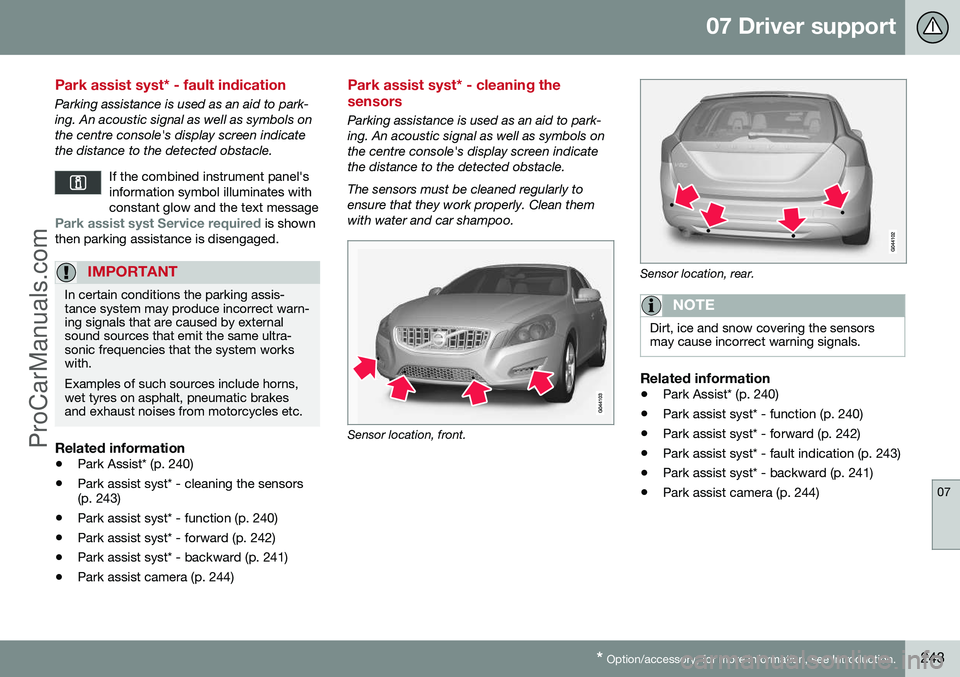
07 Driver support
07
* Option/accessory, for more information, see Introduction.243
Park assist syst* - fault indication
Parking assistance is used as an aid to park- ing. An acoustic signal as well as symbols onthe centre console's display screen indicatethe distance to the detected obstacle.
If the combined instrument panel'sinformation symbol illuminates withconstant glow and the text message
Park assist syst Service required is shown
then parking assistance is disengaged.
IMPORTANT
In certain conditions the parking assis- tance system may produce incorrect warn-ing signals that are caused by externalsound sources that emit the same ultra-sonic frequencies that the system workswith. Examples of such sources include horns, wet tyres on asphalt, pneumatic brakesand exhaust noises from motorcycles etc.
Related information
• Park Assist* (p. 240)
• Park assist syst* - cleaning the sensors (p. 243)
• Park assist syst* - function (p. 240)
• Park assist syst* - forward (p. 242)
• Park assist syst* - backward (p. 241)
• Park assist camera (p. 244)
Park assist syst* - cleaning the sensors
Parking assistance is used as an aid to park- ing. An acoustic signal as well as symbols onthe centre console's display screen indicatethe distance to the detected obstacle. The sensors must be cleaned regularly to ensure that they work properly. Clean themwith water and car shampoo.
Sensor location, front.
Sensor location, rear.
NOTE
Dirt, ice and snow covering the sensors may cause incorrect warning signals.
Related information
•Park Assist* (p. 240)
• Park assist syst* - function (p. 240)
• Park assist syst* - forward (p. 242)
• Park assist syst* - fault indication (p. 243)
• Park assist syst* - backward (p. 241)
• Park assist camera (p. 244)
ProCarManuals.co’
Page 253 of 442
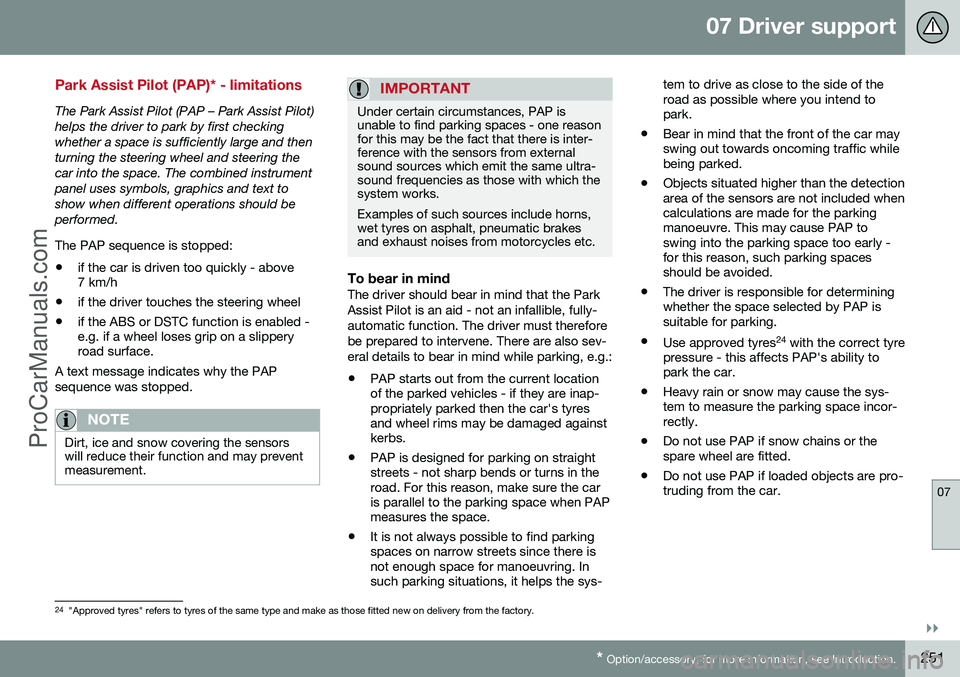
07 Driver support
07
}}
* Option/accessory, for more information, see Introduction.251
Park Assist Pilot (PAP)* - limitations
The Park Assist Pilot (PAP – Park Assist Pilot) helps the driver to park by first checkingwhether a space is sufficiently large and thenturning the steering wheel and steering thecar into the space. The combined instrumentpanel uses symbols, graphics and text toshow when different operations should beperformed. The PAP sequence is stopped:
• if the car is driven too quickly - above 7 km/h
• if the driver touches the steering wheel
• if the ABS or DSTC function is enabled -e.g. if a wheel loses grip on a slipperyroad surface.
A text message indicates why the PAP sequence was stopped.
NOTE
Dirt, ice and snow covering the sensors will reduce their function and may preventmeasurement.
IMPORTANT
Under certain circumstances, PAP is unable to find parking spaces - one reasonfor this may be the fact that there is inter-ference with the sensors from externalsound sources which emit the same ultra-sound frequencies as those with which thesystem works. Examples of such sources include horns, wet tyres on asphalt, pneumatic brakesand exhaust noises from motorcycles etc.
To bear in mindThe driver should bear in mind that the Park Assist Pilot is an aid - not an infallible, fully-automatic function. The driver must thereforebe prepared to intervene. There are also sev-eral details to bear in mind while parking, e.g.:
• PAP starts out from the current location of the parked vehicles - if they are inap-propriately parked then the car's tyresand wheel rims may be damaged againstkerbs.
• PAP is designed for parking on straightstreets - not sharp bends or turns in theroad. For this reason, make sure the caris parallel to the parking space when PAPmeasures the space.
• It is not always possible to find parkingspaces on narrow streets since there isnot enough space for manoeuvring. Insuch parking situations, it helps the sys- tem to drive as close to the side of theroad as possible where you intend topark.
• Bear in mind that the front of the car mayswing out towards oncoming traffic whilebeing parked.
• Objects situated higher than the detectionarea of the sensors are not included whencalculations are made for the parkingmanoeuvre. This may cause PAP toswing into the parking space too early -for this reason, such parking spacesshould be avoided.
• The driver is responsible for determiningwhether the space selected by PAP issuitable for parking.
• Use approved tyres 24
with the correct tyre
pressure - this affects PAP's ability topark the car.
• Heavy rain or snow may cause the sys-tem to measure the parking space incor-rectly.
• Do not use PAP if snow chains or the
spare wheel are fitted.
• Do not use PAP if loaded objects are pro-truding from the car.
24
"Approved tyres" refers to tyres of the same type and make as those fitted new on delivery from the factory.
ProCarManuals.co’
Page 305 of 442
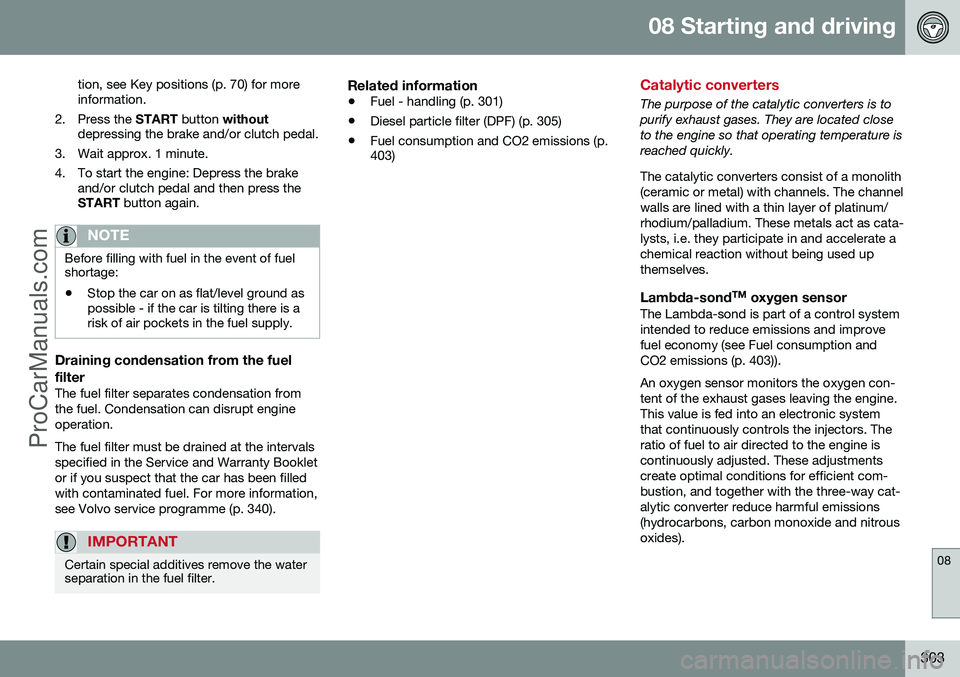
08 Starting and driving
08
303
tion, see Key positions (p. 70) for more information.
2. Press the START button without
depressing the brake and/or clutch pedal.
3. Wait approx. 1 minute.
4. To start the engine: Depress the brake and/or clutch pedal and then press the START button again.
NOTE
Before filling with fuel in the event of fuel shortage:
• Stop the car on as flat/level ground as possible - if the car is tilting there is arisk of air pockets in the fuel supply.
Draining condensation from the fuel filter
The fuel filter separates condensation from the fuel. Condensation can disrupt engineoperation. The fuel filter must be drained at the intervals specified in the Service and Warranty Bookletor if you suspect that the car has been filledwith contaminated fuel. For more information,see Volvo service programme (p. 340).
IMPORTANT
Certain special additives remove the water separation in the fuel filter.
Related information
•
Fuel - handling (p. 301)
• Diesel particle filter (DPF) (p. 305)
• Fuel consumption and CO2 emissions (p. 403)
Catalytic converters
The purpose of the catalytic converters is to purify exhaust gases. They are located closeto the engine so that operating temperature isreached quickly. The catalytic converters consist of a monolith (ceramic or metal) with channels. The channelwalls are lined with a thin layer of platinum/rhodium/palladium. These metals act as cata-lysts, i.e. they participate in and accelerate achemical reaction without being used upthemselves.
Lambda-sond TM
oxygen sensorThe Lambda-sond is part of a control systemintended to reduce emissions and improvefuel economy (see Fuel consumption andCO2 emissions (p. 403)). An oxygen sensor monitors the oxygen con- tent of the exhaust gases leaving the engine.This value is fed into an electronic systemthat continuously controls the injectors. Theratio of fuel to air directed to the engine iscontinuously adjusted. These adjustmentscreate optimal conditions for efficient com-bustion, and together with the three-way cat-alytic converter reduce harmful emissions(hydrocarbons, carbon monoxide and nitrousoxides).
ProCarManuals.co’
Page 346 of 442
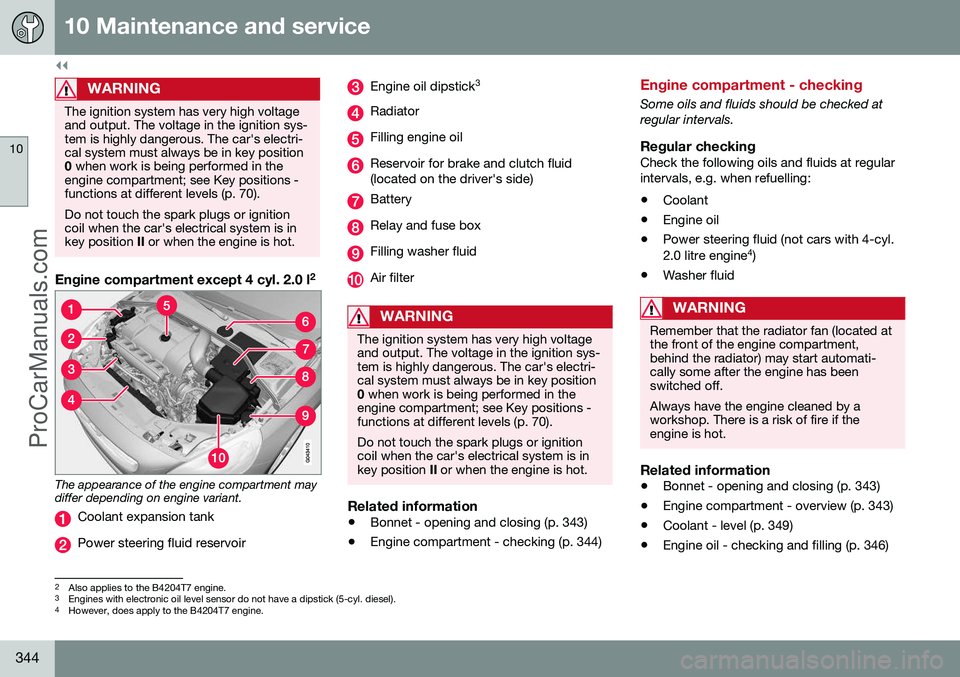
||
10 Maintenance and service
10
344
WARNING
The ignition system has very high voltage and output. The voltage in the ignition sys-tem is highly dangerous. The car's electri-cal system must always be in key position0 when work is being performed in the
engine compartment; see Key positions -functions at different levels (p. 70). Do not touch the spark plugs or ignition coil when the car's electrical system is inkey position II or when the engine is hot.
Engine compartment except 4 cyl. 2.0 l 2
The appearance of the engine compartment may differ depending on engine variant.
Coolant expansion tank
Power steering fluid reservoir
Engine oil dipstick
3
Radiator
Filling engine oil
Reservoir for brake and clutch fluid (located on the driver's side)
Battery
Relay and fuse box
Filling washer fluid
Air filter
WARNING
The ignition system has very high voltage and output. The voltage in the ignition sys-tem is highly dangerous. The car's electri-cal system must always be in key position0
when work is being performed in the
engine compartment; see Key positions -functions at different levels (p. 70). Do not touch the spark plugs or ignition coil when the car's electrical system is inkey position II or when the engine is hot.
Related information
• Bonnet - opening and closing (p. 343)
• Engine compartment - checking (p. 344)
Engine compartment - checking
Some oils and fluids should be checked at regular intervals.
Regular checkingCheck the following oils and fluids at regularintervals, e.g. when refuelling:
• Coolant
• Engine oil
• Power steering fluid (not cars with 4-cyl. 2.0 litre engine 4
)
• Washer fluid
WARNING
Remember that the radiator fan (located at the front of the engine compartment,behind the radiator) may start automati-cally some after the engine has beenswitched off. Always have the engine cleaned by a workshop. There is a risk of fire if theengine is hot.
Related information
• Bonnet - opening and closing (p. 343)
• Engine compartment - overview (p. 343)
• Coolant - level (p. 349)
• Engine oil - checking and filling (p. 346)
2
Also applies to the B4204T7 engine.3 Engines with electronic oil level sensor do not have a dipstick (5-cyl. diesel).
4 However, does apply to the B4204T7 engine.
ProCarManuals.co’
Page 377 of 442
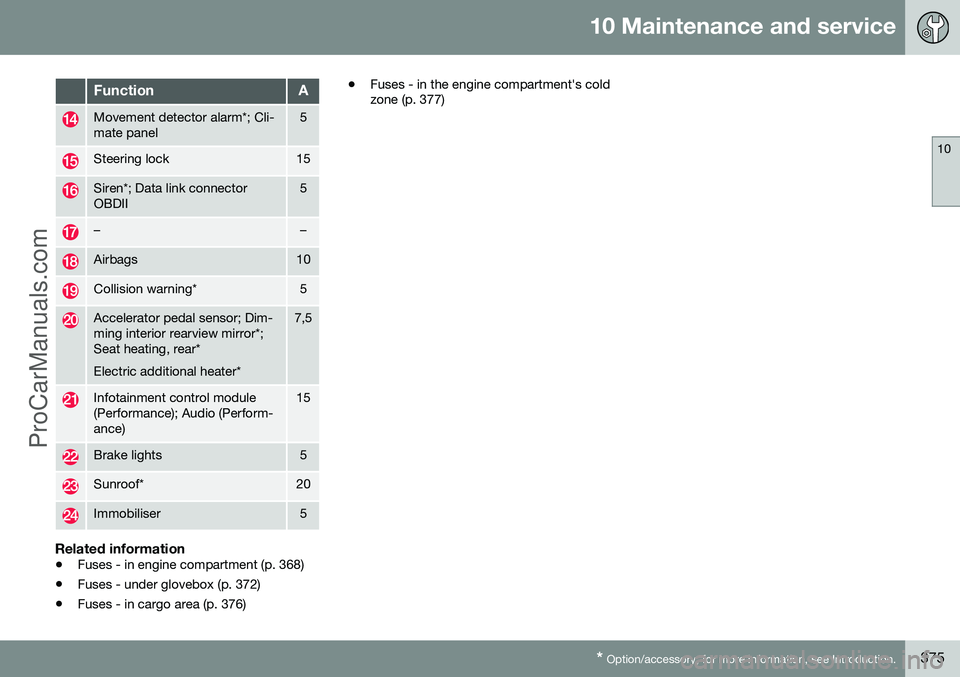
10 Maintenance and service
10
* Option/accessory, for more information, see Introduction.375
FunctionA
Movement detector alarm*; Cli- mate panel5
Steering lock15
Siren*; Data link connector OBDII5
––
Airbags10
Collision warning*5
Accelerator pedal sensor; Dim- ming interior rearview mirror*;Seat heating, rear* Electric additional heater*7,5
Infotainment control module (Performance); Audio (Perform-ance)15
Brake lights5
Sunroof*20
Immobiliser5
Related information
• Fuses - in engine compartment (p. 368)
• Fuses - under glovebox (p. 372)
• Fuses - in cargo area (p. 376) •
Fuses - in the engine compartment's cold zone (p. 377)
ProCarManuals.co’
Page 428 of 442
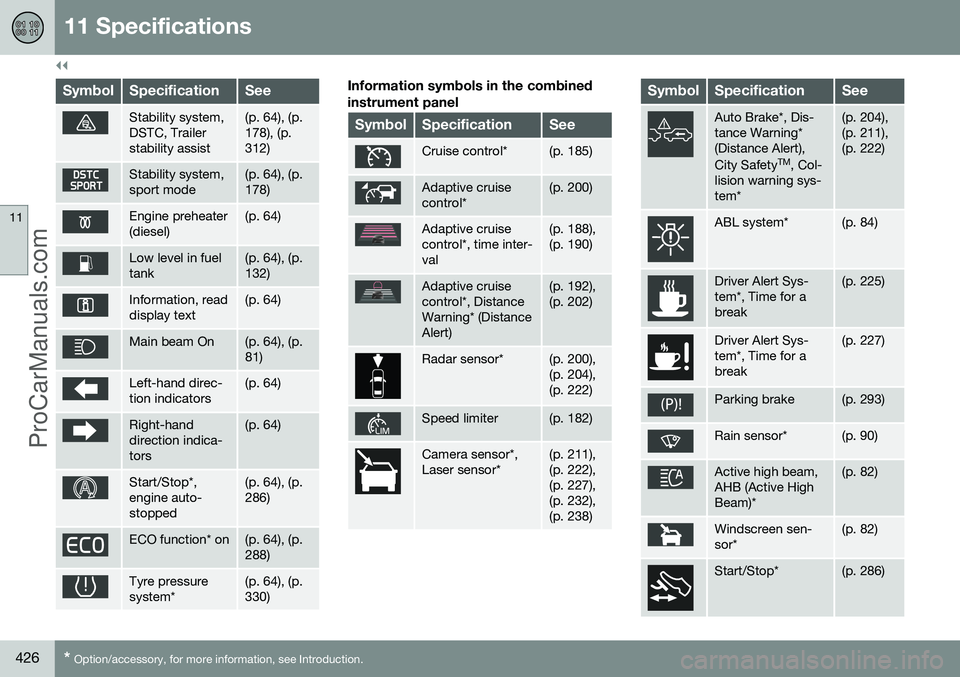
||
11 Specifications
11
426* Option/accessory, for more information, see Introduction.
SymbolSpecificationSee
Stability system, DSTC, Trailerstability assist(p. 64), (p. 178), (p.312)
Stability system, sport mode(p. 64), (p. 178)
Engine preheater (diesel)(p. 64)
Low level in fuel tank(p. 64), (p. 132)
Information, read display text(p. 64)
Main beam On(p. 64), (p. 81)
Left-hand direc- tion indicators(p. 64)
Right-hand direction indica-tors(p. 64)
Start/Stop*, engine auto-stopped(p. 64), (p. 286)
ECO function* on(p. 64), (p. 288)
Tyre pressure system*(p. 64), (p. 330)
Information symbols in the combined instrument panel
SymbolSpecificationSee
Cruise control*(p. 185)
Adaptive cruise control*(p. 200)
Adaptive cruise control*, time inter-val(p. 188), (p. 190)
Adaptive cruise control*, DistanceWarning* (DistanceAlert)(p. 192), (p. 202)
Radar sensor*(p. 200), (p. 204),(p. 222)
Speed limiter(p. 182)
Camera sensor*, Laser sensor*(p. 211), (p. 222),(p. 227),(p. 232),(p. 238)
SymbolSpecificationSee
Auto Brake*, Dis- tance Warning*(Distance Alert), City Safety TM
, Col-
lision warning sys- tem*(p. 204), (p. 211),(p. 222)
ABL system*(p. 84)
Driver Alert Sys- tem*, Time for abreak(p. 225)
Driver Alert Sys- tem*, Time for abreak(p. 227)
Parking brake(p. 293)
Rain sensor*(p. 90)
Active high beam, AHB (Active HighBeam)*(p. 82)
Windscreen sen- sor*(p. 82)
Start/Stop*(p. 286)
ProCarManuals.co’
Page 431 of 442
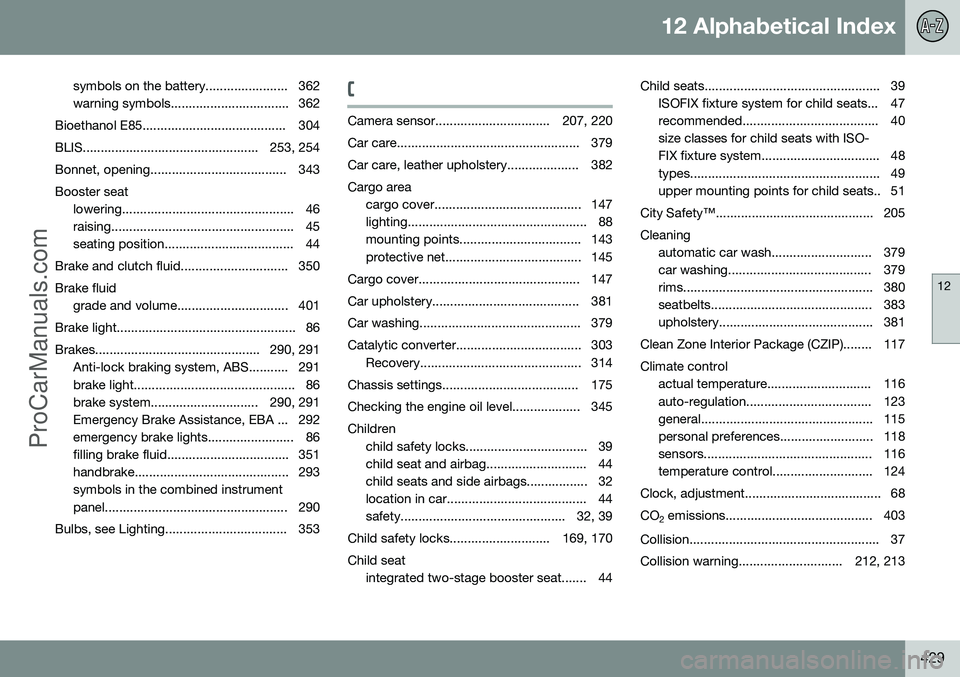
12 Alphabetical Index
12
429
symbols on the battery....................... 362
warning symbols................................. 362
Bioethanol E85........................................ 304
BLIS................................................. 253, 254
Bonnet, opening...................................... 343Booster seat lowering................................................ 46
raising................................................... 45
seating position.................................... 44
Brake and clutch fluid.............................. 350 Brake fluid grade and volume............................... 401
Brake light.................................................. 86
Brakes.............................................. 290, 291 Anti-lock braking system, ABS........... 291
brake light............................................. 86
brake system.............................. 290, 291
Emergency Brake Assistance, EBA ... 292
emergency brake lights........................ 86
filling brake fluid.................................. 351
handbrake........................................... 293symbols in the combined instrument
panel................................................... 290
Bulbs, see Lighting.................................. 353
C
Camera sensor................................ 207, 220
Car care................................................... 379
Car care, leather upholstery.................... 382Cargo area cargo cover......................................... 147
lighting.................................................. 88
mounting points.................................. 143
protective net...................................... 145
Cargo cover............................................. 147
Car upholstery......................................... 381
Car washing............................................. 379
Catalytic converter................................... 303 Recovery............................................. 314
Chassis settings...................................... 175
Checking the engine oil level................... 345Children child safety locks.................................. 39
child seat and airbag............................ 44
child seats and side airbags................. 32
location in car....................................... 44
safety.............................................. 32, 39
Child safety locks............................ 169, 170 Child seat integrated two-stage booster seat....... 44 Child seats................................................. 39
ISOFIX fixture system for child seats... 47
recommended...................................... 40size classes for child seats with ISO-
FIX fixture system................................. 48
types..................................................... 49
upper mounting points for child seats.. 51
City Safety™............................................ 205 Cleaning automatic car wash............................ 379
car washing........................................ 379
rims..................................................... 380
seatbelts............................................. 383
upholstery........................................... 381
Clean Zone Interior Package (CZIP)........ 117 Climate control actual temperature............................. 116
auto-regulation................................... 123
general................................................ 115
personal preferences.......................... 118
sensors............................................... 116
temperature control............................ 124
Clock, adjustment...................................... 68 CO 2 emissions......................................... 403
Collision..................................................... 37
Collision warning............................. 212, 213
ProCarManuals.co’